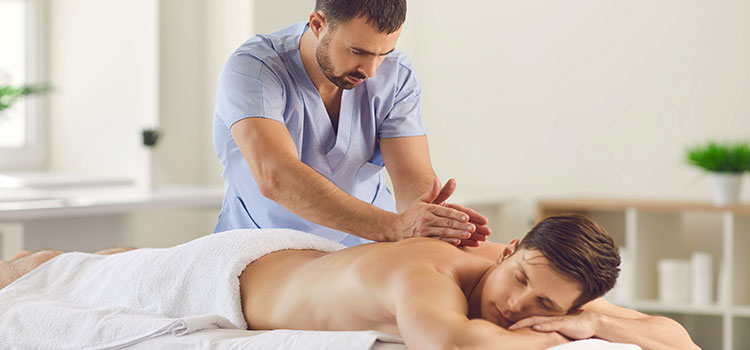In This Article
- Deep Tissue Massage Training
- Palliative Care Massage Therapy
- Medical Massage Therapy
- Sports Massage Therapy
- Massage Therapy in California
- Massage Therapy in Florida
- Massage Therapy in Arizona
- Massage Therapy in New York
- Massage Therapy in Texas
- Massage Therapy in Virginia
- Massage Therapy South Carolina
- Massage Therapy in Connecticut
How to become a massage therapist in Maryland

Maryland recently made changes to their massage therapy education and licensure requirements. Until the summer of 2023, there were two levels of massage therapy professionals in Maryland, each with its own educational requirements and scope of practice. Under new regulations voted into law by the Maryland Board of Massage Therapy Examiners at the end of 2022, there will now be one tier of massage therapist practice in the state. All massage therapists in Maryland will be required to earn Licensed Massage Therapist (LMT) licensure.
The new requirements will go into effect in 2026.
“Massage therapy has become one of the most used complementary health approaches in the United States.”
-Kirsten Hansen
“Massage therapy has become one of the most used complementary health approaches in the United States,” said Kirsten Hansen, Director of the Massage Therapy Program at the Allegany College of Maryland. “One of the developments we’re seeing in massage is that, as physicians and nurses become more familiar with the benefits of massage, they’re now very often recommended it to their patients.”
How to become a massage therapist in Maryland
Aspiring massage therapists in Maryland need to meet set requirements. Until October 31, 2026, massage therapists will be able to work in the state if they’ve earned one of two possible qualifications:
After November 1, 2026, massage therapists will need to earn an LMT license to practice. New regulations require the completion of a massage therapy educational program that is at least 750 hours long. However, this doesn’t mean you’ll be able to earn an RMP qualification until 2026. In fact, the Maryland Board of Massage Therapy Examiners stopped issuing the RMP on October 1, 2023.
It does mean that if you already have an RMP qualification, you’ll be able to work in the state until October 31, 2026. To keep working after that date, you’ll need to take another 150 hours of massage therapy coursework. This will allow you to apply for LMT licensure. Massage therapy programs in Maryland are adjusting their curriculum to meet these new requirements.
Completing a program isn’t the only requirement you’ll need to meet before you can work as a massage therapist in Maryland. The state has numerous other requirements. These requirements aren’t changing. To obtain a license, you’ll need to:
Educational program requirements
You’ll need to complete an accredited massage therapy educational program before you work as a massage therapist in Maryland. In addition to accreditation, the state requires that your program includes instruction in:
● Anatomy
● Physiology
● Massage therapy types and theory
● Contraindications and pathology
● Professional ethics
● Health and hygiene
● Research
● Hands–on techniques (with supervision during instruction)
● Clinical assessment and documentation
“Those hands-on classes, that’s where you learn the modalities, the careful skills that you’ll need in practice,” explained Hansen.
Exam and license requirements
Maryland requires two exams before you can work in the state. The first step is taking a national exam. Maryland accepts passing scores on the following exams:
● The Massage & Bodywork Licensing Examination (MBLEx) administered by the Federation of State Massage Therapy Boards (FSMTB)
● The examination for Board Certification in Therapeutic Massage and Bodywork from the National Certification Board for Therapeutic Massage and Bodywork (NCBTMB)
● National Board Exams from the National Certification Commission for Acupuncture and Oriental Medicine (NCCAOM)
Each exam has its own qualification requirements, but you can count on being asked for proof that you’ve completed an accredited massage therapy program. Once you’ve taken and passed one of these exams, you can apply to take the Maryland Jurisprudence Exam.
Once you pass your Maryland Jurisprudence exam, you’ll be able to work in the state. However, as a last step, you might also need to take a few steps with your local government. For instance, in Montgomery County, Maryland, massage therapists are required to register with the county every two years.
CE for massage therapists in Maryland
You’ll need continuing education credits to keep your license current in Maryland. The state asks that you earn 24 hours every two years. Your credits will need to incorporate specific topics. This includes:
● 1 hour in diversity or cultural competency
● 3 hours in professional ethics or jurisprudence
● 3 hours in communicable disease education that includes HIV/AIDs
● 17 hours in massage-related courses that have been approved by the Board.
The Maryland Board allows massage therapists to earn CEs with in-person courses, at-home courses and online courses. They also allow massage therapists to earn up to 12 hours of their CEs through programs at approved conferences, meetings, conventions and other professional events. You’ll be asked to send in proof of your courses, along with proof you’ve kept your CPR certification up-to-date.
Legal considerations for massage therapists in Maryland
You can practice massage therapy in Maryland for up to seven consecutive days with a license from another state. You’ll need to fill out an application with the Maryland Board of Massage Therapy Examiners and pay a $100 fee. If you’re moving to Maryland from another state, you’ll need to obtain a Maryland license. The steps you’ll need to take depend on the licensure rules in your current state.
For example, suppose you completed a massage therapy program of at least 600 hours and passed one of the national exams that Maryland accepts. In that case, you might send in records of your education, exam and work history to the State board. You can then take the Maryland Jurisprudence exam for licensure in the state. However, it’s important to keep in mind that your massage education will need to be from an accredited school and it will need to meet Maryland’s standards for massage therapy education.
Professional conduct and ethical guidelines
The Massage Therapy Code of Maryland Regulations (COMAR), lays out specific rules and standards of professional conduct for massage therapists in the state. Covered topics include patient relationships, informed consent, professional boundaries and patient privacy. They also discuss the ethical professional standards expected of massage therapists, including expectations surrounding criminal activity and substance abuse.
Scope of practice
Maryland law regulates the scope of practice for massage therapists in the state. The most recent definition from the Maryland Board of Massage Therapy Examiners states that:
“Massage therapy does not include, the diagnosis [or treatment] of illness, disease, or injury, the adjustment, manipulation, or mobilization of any of the articulations of the osseous structures of the human body or spine or […] the laying on of hands.”
Insurance and liability
Requirements for insurance or liability will depend on the laws that govern small businesses in your local area. Massage therapists who’ve opened their own practices can see what’s required by looking up the rules in their county, city or town. However, insurance can be a good idea even if your local government doesn’t require it.
You can find liability insurance through national associations for massage therapists such as the American Massage Therapy Association (AMTA) or the Associated Massage & Bodywork Professionals (AMBP).
Working as a massage therapist in Maryland
Massage therapist salary in Maryland
According to the U.S. Bureau of Labor Statistics (BLS), approximately 1,200 massage therapists are working in the state of Maryland. The state also pays a median annual salary of $56,960. Nationally, massage therapists earned a median annual salary of $55,310.
Although Maryland is the 9th smallest state in the country, where you live in this compact state can make a big difference in salary. As an example, massage therapists in the Baltimore metro area earned a median annual salary of $55,320, while massage therapists living the Maryland-located suburbs of both Washington, DC, and Philadelphia earned a median salary of around $60,000.
Job outlook and finding employment opportunities in Maryland
Across the country, massage therapy is a fast-growing career. The BLS estimates a growth of 18.3% through 2032. In Maryland, there are a variety of job opportunities available. If you enjoy city life, the state’s busy metro areas are home to large healthcare providers. If you’re after a more relaxed atmosphere, you’ll find plenty of spas in the picturesque towns around the Chesapeake Bay and along the Atlantic shoreline.
“Massage therapists are employed in hospitals, hospices, chiropractic offices, doctor’s offices, spas and many also end up opening their own private practices,” said Hansen. “It’s one of the fastest growing career fields out there, and there’s so much flexibility. If you’re passionate about sports, and you want to work with athletes, you can do that. If you want to work in a 5-star resort, you can do that.”
Setting up a private massage practice in Maryland
You’ll need to meet a few additional requirements to set up a private practice in Maryland. It’s best to start by looking into how to get a small business license in your town, city or county. This can vary, so it’s a good idea to search for the rules in your area. You’ll also want to ensure that your license is current.
Staying up to date on industry developments and resources
It’s always important to stay up to date with the latest in your field. For massage therapists in Maryland, this can mean paying attention to news from the Maryland State Board of Massage Therapy for changes to regulations, like the recent change to licensure and educational requirements. Beyond the Board, you can look into professional organizations for massage therapists, such as:
American Massage Therapy Association (AMTA)—AMTA offers resources, such as continuing education opportunities, industry news and research.
Associated Bodywork and Massage Professionals (ABMP)—If you want to become self-employed, ABMP can be a great resource. Their resources include marketing and tips for massage therapists, as well as a bimonthly magazine.
American Medical Massage Association (AMMA)—AMMA is dedicated to promoting massage therapy as an allied health field. If your massage therapy career is healthcare-focused, they can be a beneficial resource.
Finding your massage therapy calling
The first step to your massage therapy career in Maryland is an education. You’ll need to find an accredited program of at least 750 hours. The Maryland State Board of Massage Therapy Examiners maintains a list of accredited schools. It’s a good place to start comparing programs that serve the state. Our Find Schools button can also help you get started.


With professional insights from:
Kirsten Hansen, LMT
Program Director, Massage Therapy Program, Allegany College of Maryland


